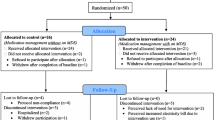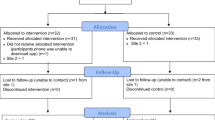Abstract
Objective
The aim of this study was to assess the feasibility and preliminary outcomes of a medication self-management platform for chronically ill patients, Medplan.
Methods
We performed a 6-month single-arm prospective pre-post intervention study of patients receiving treatment for hypertension and/or dyslipidemia and/or heart failure and/or human immunodeficiency virus infection. During the pre-intervention phase, participants were followed according to their usual care; during the intervention phase, they used Medplan. We evaluated adherence, health outcomes, healthcare resources and measured the satisfaction of patients and health care professionals.
Results
The study population comprised 42 patients. No differences were found in adherence to medication measured by proportion of days covered with medication (PDC). However, when adherence was measured using the SMAQ, the percentage of adherent patients improved during the intervention phase (p < 0.05), and the number of days with missed doses decreased (p < 0.05). Adherence measured using the Medplan app showed poor concordance with PDC. No differences were found in health outcomes or in the use of health care resources during the study period. The mean satisfaction score for Medplan was 7.2 ± 2.7 out of 10 among patients and 7.3 ± 1.7 among health care professionals. In fact, 71.4 % of participants said they would recommend the app to a friend, and 88.1 % wanted to continue using it.
Conclusion
The Medplan platform proved to be feasible and was well accepted by its users. However, its impact on adherence differed depending on the assessment method. The lack of effect on PDC is mainly because patients were already good adherers at baseline. The study enabled us to validate the platform in real patients using many different mobile devices and to identify potential barriers to scaling up the platform.









Similar content being viewed by others
References
Osterberg, L., and Blaschke, T., Adherence to medication. N. Engl. J. Med. 353(5):487–497, 2005. doi:10.1056/NEJMra050100.
WHO | ADHERENCE TO LONG-TERM THERAPIES: EVIDENCE FOR ACTION. World Health Organization http://www.who.int/chp/knowledge/publications/adherence_report/en/. Accessed February 19, 2014.
Viswanathan, M., Golin, C. E., Jones, C. D., et al., Interventions to improve adherence to self-administered medications for chronic diseases in the United States: a systematic review. Ann. Intern. Med. 157(11):785–795, 2012. doi:10.7326/0003-4819-157-11-201212040-00538.
Garfield, S., Clifford, S., Eliasson, L., Barber, N., and Willson, A., Suitability of measures of self-reported medication adherence for routine clinical use: a systematic review. BMC Med. Res. Methodol. 11:149, 2011. doi:10.1186/1471-2288-11-149.
Ho, P. M., Bryson, C. L., and Rumsfeld, J. S., Medication adherence: its importance in cardiovascular outcomes. Circulation 119(23):3028–3035, 2009. doi:10.1161/CIRCULATIONAHA.108.768986.
Bosworth, H. B., Granger, B. B., Mendys, P., et al., Medication adherence: a call for action. Am. Heart J. 162(3):412–424, 2011. doi:10.1016/j.ahj.2011.06.007.
Anglada-Martinez, H., Riu-Viladoms, G., Martin-Conde, M., Rovira-Illamola, M., Sotoca-Momblona, J. M., and Codina-Jane, C., Does mHealth increase adherence to medication? Results of a systematic review. Int. J. Clin. Pract. 69(1):9–32, 2014. doi:10.1111/ijcp.12582.
Hamine, S., Gerth-Guyette, E., Faulx, D., Green, B. B., and Ginsburg, A. S., Impact of mHealth Chronic Disease Management on Treatment Adherence and Patient Outcomes: A Systematic Review. J. Med. Internet Res. 17(2):e52, 2015. doi:10.2196/jmir.3951.
Lester, R. T., Ritvo, P., Mills, E. J., et al., Effects of a mobile phone short message service on antiretroviral treatment adherence in Kenya (WelTel Kenya1): a randomised trial. Lancet 376(9755):1838–1845, 2010. doi:10.1016/S0140-6736(10)61997-6.
Pop-Eleches, C., Thirumurthy, H., Habyarimana, J. P., et al., Mobile phone technologies improve adherence to antiretroviral treatment in a resource-limited setting: a randomized controlled trial of text message reminders. AIDS 25(6):825–834, 2011. doi:10.1097/QAD.0b013e32834380c1.
Mbuagbaw, L., Thabane, L., Ongolo-Zogo, P., et al., The Cameroon Mobile Phone SMS (CAMPS) trial: a randomized trial of text messaging versus usual care for adherence to antiretroviral therapy. PLoS One 7(12):e46909, 2012. doi:10.1371/journal.pone.0046909.
Strandbygaard, U., Thomsen, S. F., and Backer, V., A daily SMS reminder increases adherence to asthma treatment: a three-month follow-up study. Respir. Med. 104(2):166–171, 2010. doi:10.1016/j.rmed.2009.10.003.
Petrie, K. J., Perry, K., Broadbent, E., and Weinman, J., A text message programme designed to modify patients’ illness and treatment beliefs improves self-reported adherence to asthma preventer medication. Br. J. Health Psychol. 17(1):74–84, 2012. doi:10.1111/j.2044-8287.2011.02033.x.
Park, L. G., Howie-Esquivel, J., Chung, M. L., and Dracup, K., A text messaging intervention to promote medication adherence for patients with coronary heart disease: a randomized controlled trial. Patient Educ. Couns. 94(2):261–268, 2014. doi:10.1016/j.pec.2013.10.027.
Márquez Contreras, E., de la Figuera von Wichmann, M., Gil Guillén, V., et al., Effectiveness of an intervention to provide information to patients with hypertension as short text messages and reminders sent to their mobile phone (HTA-Alert). Aten. Primaria 34(8):399–405, 2004. http://www.ncbi.nlm.nih.gov/pubmed/15546536. Accessed February 19, 2014.
Bert, F., Giacometti, M., Gualano, M. R., and Siliquini, R., Smartphones and health promotion: a review of the evidence. J. Med. Syst. 38(1):9995, 2014. doi:10.1007/s10916-013-9995-7.
“Global Mobile Health Trends and Figures Market Report 2013–2017.” http://research2guidance.com/500m-people-will-be-using-healthcare-mobile-applications-in-2015/. Accessed June 30, 2014.
mHealth. Healthcare mobile apps, devices and solutions. Infographic. http://www.ticbeat.com/sim/contribucion-moviles-salud-infografia/ Accessed February 19, 2014.
Patel, S., Jacobus-Kantor, L., Marshall, L., et al., Mobilizing your medications: an automated medication reminder application for mobile phones and hypertension medication adherence in a high-risk urban population. J. Diabetes Sci. Technol. 7(3):630–639, 2013. http://www.ncbi.nlm.nih.gov/pubmed/23759395. Accessed February 19, 2014.
Mobile Pillbox App Promotes Diabetes Medication Adherence: Report [Internet]. http://www.eweek.com/mobile/mobile-pillbox-app-promotes-diabetes-medication-adherence-Report/. Accessed February 19, 2014.
Ryan, D., Price, D., Musgrave, S. D., et al., Clinical and cost effectiveness of mobile phone supported self monitoring of asthma: multicentre randomised controlled trial. BMJ 344:e1756, 2012. doi:10.1136/bmj.e1756.
Cano Martín, J. A., Martínez-Pérez, B., de la Torre-Díez, I., and López-Coronado, M., Economic impact assessment from the use of a mobile app for the self-management of heart diseases by patients with heart failure in a Spanish region. J. Med. Syst. 38(9):96, 2014. doi:10.1007/s10916-014-0096-z.
Grindrod, K. A., Li, M., and Gates, A., Evaluating user perceptions of mobile medication management applications with older adults: a usability study. JMIR mHealth uHealth 2(1):e11, 2014. doi:10.2196/mhealth.3048.
Al Ghamdi, E., Yunus, F., Da’ar, O., et al., The Effect of Screen Size on Mobile Phone User Comprehension of Health Information and Application Structure: An Experimental Approach. J. Med. Syst. 40(1):11, 2016. doi:10.1007/s10916-015-0381-5.
Zapata, B. C., Fernández-Alemán, J. L., Idri, A., and Toval, A., Empirical studies on usability of mHealth apps: a systematic literature review. J. Med. Syst. 39(2):1, 2015. doi:10.1007/s10916-014-0182-2.
Herdman, M., Badia, X., and Berra, S., El EuroQol-5D: una alternativa sencilla para la medición de la calidad de vida relacionada con la salud en atención primaria. Aten. Primaria 28(06):425–430, 2001.
Knobel, H., Alonso, J., Casado, J. L., et al., Validation of a simplified medication adherence questionnaire in a large cohort of HIV-infected patients: the GEEMA Study. AIDS 16(4):605–613, 2002.
Shalansky, S. J., Levy, A. R., and Ignaszewski, A. P., Self-reported Morisky score for identifying nonadherence with cardiovascular medications. Ann. Pharmacother. 38(9):1363–1368, 2004. doi:10.1345/aph.1E071.
Morisky, D. E., Green, L. W., and Levine, D. M., Concurrent and predictive validity of a self-reported measure of medication adherence. Med. Care 24(1):67–74, 1986.
Ortega Suárez, F. J., Sánchez Plumed, J., Pérez Valentín, M. A., Pereira Palomo, P., Muñoz Cepeda, M. A., and Lorenzo, A. D., Validation on the simplified medication adherence questionnaire (SMAQ) in renal transplant patients on tacrolimus. Nefrologia 31(6):690–696, 2011. doi:10.3265/Nefrologia.pre2011.Aug.10973.
Haynes, R. B., McKibbon, K. A., and Kanani, R., Systematic review of randomised trials of interventions to assist patients to follow prescriptions for medications. Lancet 348(9024):383–386, 1996.
Horne, R., and Weinman, J., Patients’ beliefs about prescribed medicines and their role in adherence to treatment in chronic physical illness. J. Psychosom. Res. 47(6):555–567, 1999.
Labrecque, M., Laurier, C., Champagne, F., Kennedy, W., Paré, M., and Cartier, A., Effect of age on the conformity rate to short-acting beta-agonist use criteria in asthma. J. Asthma 40(7):829–835, 2003.
Degli Esposti, E., Di Martino, M., Sturani, A., et al., Risk factors for uncontrolled hypertension in Italy. J. Hum. Hypertens. 18(3):207–213, 2004. doi:10.1038/sj.jhh.1001656.
Mbuagbaw, L., van der Kop, M. L., Lester, R. T., et al., Mobile phone text messages for improving adherence to antiretroviral therapy (ART): an individual patient data meta-analysis of randomised trials. BMJ Open 3(12):e003950, 2013. doi:10.1136/bmjopen-2013-003950.
McCarney, R., Warner, J., Iliffe, S., van Haselen, R., Griffin, M., and Fisher, P., The Hawthorne Effect: a randomised, controlled trial. BMC Med. Res. Methodol. 7:30, 2007. doi:10.1186/1471-2288-7-30.
Goldstein, C. M., Gathright, E. C., Dolansky, M. A., et al., Randomized controlled feasibility trial of two telemedicine medication reminder systems for older adults with heart failure. J. Telemed. Telecare 20(6):293–299, 2014. doi:10.1177/1357633X14541039.
Mira, J. J., Navarro, I., Botella, F., et al., A Spanish pillbox app for elderly patients taking multiple medications: randomized controlled trial. J. Med. Internet Res. 16(4):e99, 2014. doi:10.2196/jmir.3269.
¿Conoce Canal Paciente? - Noticias - CAPs Les Corts, Casanova i Comte Borrell. http://www.capcasanova.cat/es_noticies/view.php?ID=154. Accessed April 29, 2015.
McGillicuddy, J. W., Weiland, A. K., Frenzel, R. M., et al., Patient attitudes toward mobile phone-based health monitoring: questionnaire study among kidney transplant recipients. J. Med. Internet Res. 15(1):e6, 2013. doi:10.2196/jmir.2284.
Author information
Authors and Affiliations
Corresponding author
Ethics declarations
Conflict of Interest
Authors have no conflict of interest to declare.
Additional information
This article is part of the Topical Collection on Mobile Systems
Rights and permissions
About this article
Cite this article
Anglada-Martínez, H., Martin-Conde, M., Rovira-Illamola, M. et al. Feasibility and Preliminary Outcomes of a Web and Smartphone–Based Medication Self-Management Platform for Chronically Ill Patients. J Med Syst 40, 99 (2016). https://doi.org/10.1007/s10916-016-0456-y
Received:
Accepted:
Published:
DOI: https://doi.org/10.1007/s10916-016-0456-y




